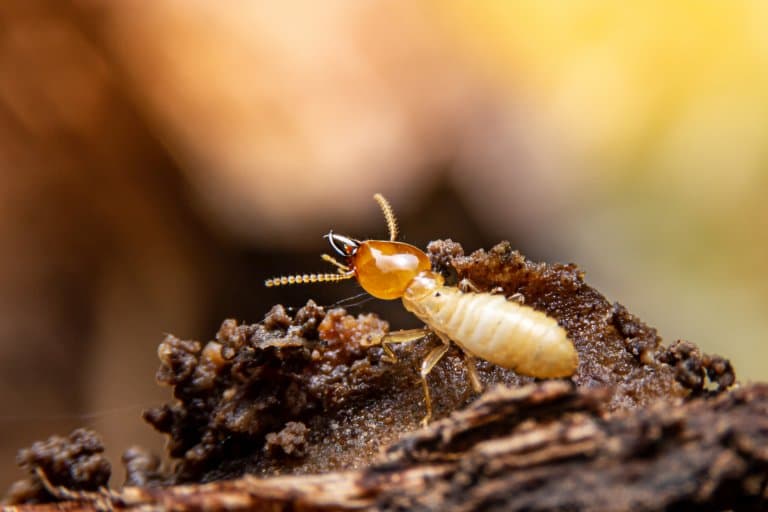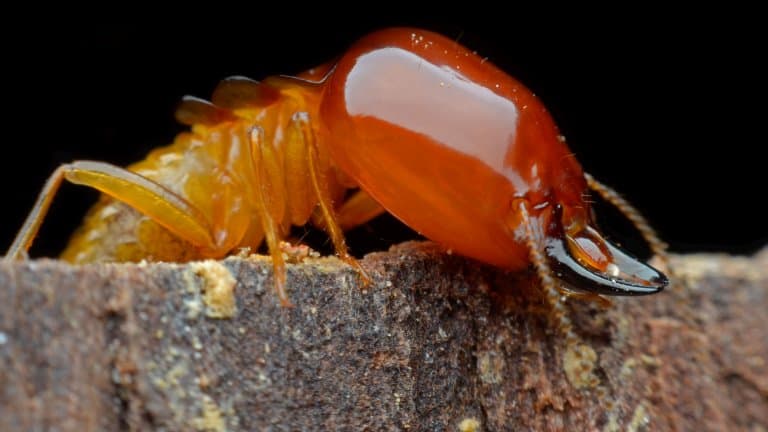Termite Profile
Around 4,000 years ago, a colony of animals built a structure so large that the amount of earth moved was equivalent to 4,000 times the amount used in the construction of the Great pyramids of Giza.
A single species built a subterranean city the size of Britain under the Earth in Brazil discovered only a few years ago. It was a species of termite, one of the most underrated animals there is!

Termite Facts Overview
| Habitat: | Subterranean |
| Location: | Every continent except Antarctica |
| Lifespan: | Queens can survive more than ten years |
| Size: | 2-15mm, queen up to 10cm (4in) long |
| Weight: | <1g |
| Color: | Orange-white |
| Diet: | Decaying leaf litter and wood |
| Predators: | Everything: mammals, birds, insects, scorpions, lizards, spiders |
| Top Speed: | Slow |
| No. of Species: |
Around 3,000 |
| Conservation Status: |
Most either not listed or Least Concern. Two species Critically Endangered (IUCN) |
Termites are a strange bunch. We really only consider them as the destructive force behind the collapse of a lot of wooden houses, but they’re actually one of the most successful organisms on Earth; occupying cracks and crevices in almost every country outside of Antarctica.
They build vast, extensive underground complexes that can be the size of countries and have intricate air ventilation and thermoregulation systems!
Yet, we’re still discovering new things about these incredible animals, and despite their numbers, abundance, and diversity, they hold many more secrets.
Interesting Termite Facts
1. They’re not ants!
Termites were previously believed to be related to ants. They look a lot like ants, and they behave a lot like them, too. They dig under the ground, bite your feet, and work as a huge colony to branch out and take over any local food source, just like ants.
Despite realising that they’re not quite ants, taxonomists still didn’t understand quite how peculiar termites are. For the longest time, they occupied their own order, Isoptera but recent molecular analyses have shown a remarkably close relation to cockroaches!
With this revelation, they’ve been added to the cockroach order, Blattodea, and Isoptera has been redefined as an infraorder.
Now that everyone’s looking at them through this lens, it’s starting to make sense. Even though they have very different social structures, they share a lot of things in common with their cockroach buddies that ants do not. 1

2. They can grow up to 4.2 inches in length!
The largest ant that we have ever known about was Titanomyra gigantea, whose queens grew up to 5.5cm (2 inches) long.
In contrast, the largest cockroach is the hilariously-named Megaloblatta longipennis reaching 11.4cm (4.5 inches) long.
For comparison, the largest termite queen is Macrotermes bellicosus, and she reaches very similar proportions. So, to start with, termites and cockroaches grow to very similar sizes, much larger than any ants that have ever lived. 2
3. They’re a delicacy
While hard to come by, termite queens are considered a rare treat in many parts of the insect-eating world. Soldiers are commonly eaten, but finding an enormous queen is a true delicacy. They’re packed full of nutrients and, apparently, very tasty.
They’re eaten for health, and medicinally. In Mali, they’re thought to increase a person’s social standing. In some traditional Ugandan cultures, only the chief was allowed to eat them.
Much like any strange food, some people are going to assume termite queens have aphrodisiac purposes. This probably isn’t true, but it’s always a popular excuse. 3
4. They’re headbangers
When they need to spread a warning, termites have a heavy metal alert system. By drumming in synchrony on the ground with their heads, they offer a loud threat display to a potential predator and let other members of the colony know to retreat back underground.
This drumming comes in rattling waves and can be heard from several meters away.
5. They can explode
If the early warning system doesn’t work, some species have another trick up their sleeves. Or at least, inside pouches on their backs.
Specialised salivary glands send copper-containing compounds into sacs, which can be combined with another chemical to cause an explosive reaction when the individual is threatened.
The result of this is a sticky, toxic mess that fends off invertebrate predators and helps to protect the colony.
It seems like this ability is saved for ageing workers, who will be the most dispensable in the colony. And termites have a lot of quirky colony-related efficiencies like this.
6. They change over time
While ants, wasps and bees follow a similar process of metamorphosis as many other familiar 3-stage insects like butterflies, termites grow more like crickets (or cockroaches). They have multiple moults as they age, and this has allowed them to go through what you might call mini metamorphoses.
Each moult comes with a slight change in the design of the termite, and this allows them to fill different roles as they age. 4
7. Each caste represents an organ of the superorganism
Whereas in ants, bees and wasps, the workers are usually sterile females, in some termite species, they have colonies of mixed sexes. That’s one significant difference, but there are plenty more!
Termites not only have a queen but a king, too, who stays with the queen and mates for life.
Young workers do the most for the colony when it comes to food. In fact, they act as the digestive system for the whole colony. They forage, store food, and even digest it for the others, breaking down cellulose – something which is uncommon in all of the animal kingdom – then feeding it to their family.
Soldiers are more specialised, with enormous heads and powerful jaws. They don’t even feed themselves, instead relying on the generosity of the worker caste.
Then, there are the reproductive. Fertile nymphs that become sexually mature and eventually leave the colony to find a mate.
What’s so fascinating about termite development is that the number of any caste can be changed where circumstances require it. Workers can morph into soldiers where needed or even become secondary reproductives.
This flexibility allows the colony to quickly adapt to changes in the environment. 5

8. They’re ecosystem engineers
The success of termites makes them a force to be reckoned with. They’re such a powerful influence on their environment that they’re considered ecosystem engineers.
The sheer number of them both feeds and recycles a huge amount of biomass, and the nutrients they break down are tremendously valuable to the plants that use the soil.
Like other cellulose-digesting herbivores, they produce a lot of gas. It’s been said that termites are responsible for 11% of the atmospheric methane released, with some estimates putting it much higher.
9. Ants are their greatest enenmy
Despite having a huge range of predators that will diet on them, some genera of ants are specialists in predating on termites.
The ant species Megaponera and Paltothyreus tarsatus are both termite-eating, and will either raid termite colonies to eat them, or use its mandibles to carry them off back home for lunch.
In some cultures these ant species are collected in a pot in their thousands and released into the grasses that make the roof of the house to remove termites
Other animals such as centipedes, cockroaches, crickets, spiders, aardvarks, anteaters, bats, baears and many more species will also feed on termites!
Some are capable of consuming thousands in a single night!

10. Termite queens have the longest lifespan of any insect in the world
Most insects have relatively short lifespans and most termites will live for 1-2 years.
However, some termite queens are thought to live for between 30-50 years, reproducing annually and founding numerous colonies.
Each year a queen can produce 10 million eggs, meaning they can produce up to 50 million eggs during their lifetime.
Termite Fact-File Summary
Scientific Classification
| Kingdom: | Animalia |
| Phylum: | Arthropoda |
| Class: | Insecta |
| Order: | Blattodea |
| Family: | Mastotermitidae Stolotermitidae Hodotermopsidae Hodotermitidae Archotermopsidae Kalotermitidae Archeorhinotermitidae Stylotermitidae Serritermitidae Rhinotermitidae Termitidae |
Fact Sources & References
- Biol Lett (2007), “Death of an order: a comprehensive molecular phylogenetic study confirms that termites are eusocial cockroaches”, NIH.
- “Macrotermes Bellicosus”, Science Direct.
- Arnold van Huis (2017),“Cultural significance of termites in sub-Saharan Africa”, BMC.
- Lin Edwards (2012), “Aging worker termites explode themselves in suicide missions”, Phys.org.
- Front Physiol (2014), “Social interactions affecting caste development through physiological actions in termites”, NIH.
